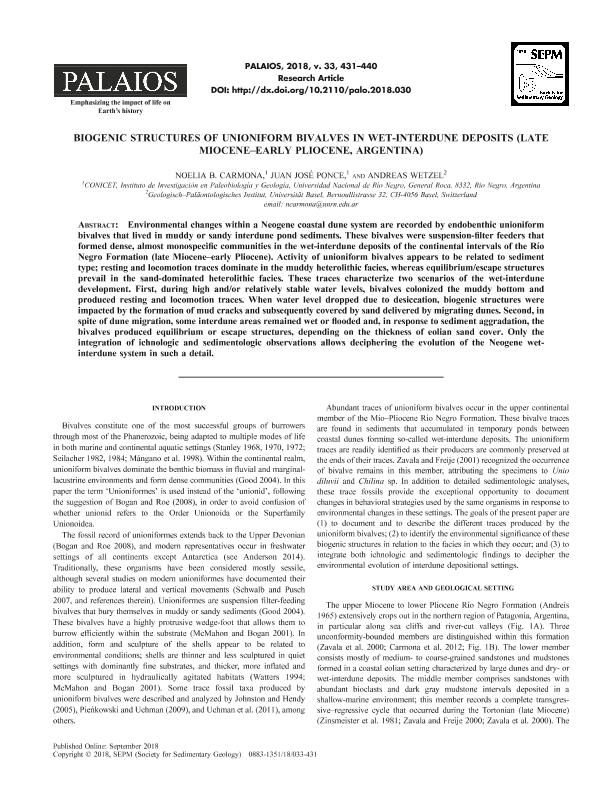Mostrar el registro sencillo del ítem
dc.contributor.author
Carmona, Noelia Beatriz

dc.contributor.author
Ponce, Juan Jose

dc.contributor.author
Wetzel, Andreas
dc.date.available
2019-11-20T20:28:20Z
dc.date.issued
2018-09
dc.identifier.citation
Carmona, Noelia Beatriz; Ponce, Juan Jose; Wetzel, Andreas; Biogenic structures of unioniform bivalves in wet-interdune deposits (Late Miocene-early Pliocene, Argentina); Society for Sedimentary Geology; Palaios; 33; 9; 9-2018; 431-440
dc.identifier.issn
0883-1351
dc.identifier.uri
http://hdl.handle.net/11336/89325
dc.description.abstract
Environmental changes within a Neogene coastal dune system are recorded by endobenthic unioniform bivalves that lived in muddy or sandy interdune pond sediments. These bivalves were suspension-filter feeders that formed dense, almost monospecific communities in the wet-interdune deposits of the continental intervals of the Río Negro Formation (late Miocene-early Pliocene). Activity of unioniform bivalves appears to be related to sediment type; resting and locomotion traces dominate in the muddy heterolithic facies, whereas equilibrium/escape structures prevail in the sand-dominated heterolithic facies. These traces characterize two scenarios of the wet-interdune development. First, during high and/or relatively stable water levels, bivalves colonized the muddy bottom and produced resting and locomotion traces. When water level dropped due to desiccation, biogenic structures were impacted by the formation of mud cracks and subsequently covered by sand delivered by migrating dunes. Second, in spite of dune migration, some interdune areas remained wet or flooded and, in response to sediment aggradation, the bivalves produced equilibrium or escape structures, depending on the thickness of eolian sand cover. Only the integration of ichnologic and sedimentologic observations allows deciphering the evolution of the Neogene wet-interdune system in such a detail.
dc.format
application/pdf
dc.language.iso
eng
dc.publisher
Society for Sedimentary Geology

dc.rights
info:eu-repo/semantics/openAccess
dc.rights.uri
https://creativecommons.org/licenses/by-nc-sa/2.5/ar/
dc.subject
Río Negro Formation
dc.subject
Trace Fossil
dc.subject
Wet-Interdune
dc.subject
Eolian Dunes
dc.subject.classification
Geología

dc.subject.classification
Ciencias de la Tierra y relacionadas con el Medio Ambiente

dc.subject.classification
CIENCIAS NATURALES Y EXACTAS

dc.title
Biogenic structures of unioniform bivalves in wet-interdune deposits (Late Miocene-early Pliocene, Argentina)
dc.type
info:eu-repo/semantics/article
dc.type
info:ar-repo/semantics/artículo
dc.type
info:eu-repo/semantics/publishedVersion
dc.date.updated
2019-08-08T19:10:50Z
dc.journal.volume
33
dc.journal.number
9
dc.journal.pagination
431-440
dc.journal.pais
Estados Unidos

dc.journal.ciudad
Lawrence
dc.description.fil
Fil: Carmona, Noelia Beatriz. Consejo Nacional de Investigaciones Científicas y Técnicas. Centro Científico Tecnológico Conicet - Patagonia Norte. Instituto de Investigación en Paleobiología y Geología; Argentina
dc.description.fil
Fil: Ponce, Juan Jose. Consejo Nacional de Investigaciones Científicas y Técnicas. Centro Científico Tecnológico Conicet - Patagonia Norte. Instituto de Investigación en Paleobiología y Geología; Argentina
dc.description.fil
Fil: Wetzel, Andreas. Universidad de Basilea; Suiza
dc.journal.title
Palaios

dc.relation.alternativeid
info:eu-repo/semantics/altIdentifier/url/https://pubs.geoscienceworld.org/sepm/palaios/article/33/9/431/548358/biogenic-structures-of-unioniform-bivalves-in-wet
dc.relation.alternativeid
info:eu-repo/semantics/altIdentifier/doi/https://doi.org/10.2110/palo.2018.030
Archivos asociados
